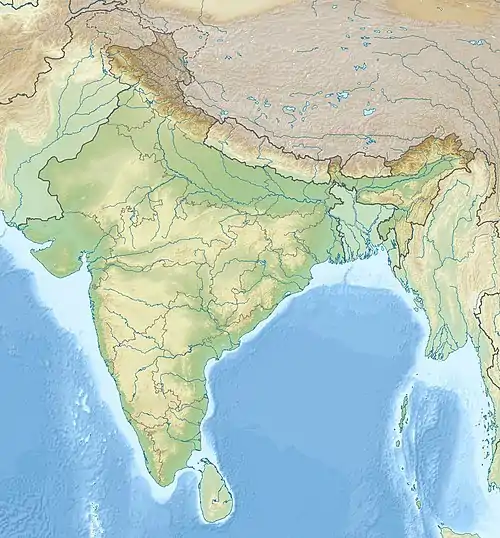Sajjangarh Wildlife Sanctuary
Sajjangarh Wildlife Sanctuary is located in Udaipur District of Rajasthan in the southern Aravalli Hills. The area of the sanctuary is 5.19 square kilometres.[1] The sanctuary is located entirely within Girwa Tehsil of Udaipur district.[1]
| Sajjangarh Wildlife Sanctuary | |
|---|---|
 Sajjangarh Wildlife Sanctuary | |
 Sajjangarh Wildlife Sanctuary  Sajjangarh Wildlife Sanctuary | |
| Location | Girwa tehsil, Udaipur district, Rajasthan, India |
| Nearest city | Udaipur, Rajasthan |
| Coordinates | 24°35′49″N 73°38′26″E |
| Area | 5.19 km2 (2.00 sq mi) |
| Governing body | Rajasthan State Forest Department |
The sanctuary is situated atop Bansdara Hill in the most vulnerable habitat of the Aravallis, one of the oldest geological formations in the world. Unfortunately, the Aravallis' biological and non-biological resources have been overused and carelessly harnessed in the sake of rapid development that has gone well beyond sustainable levels, leaving the Bansdara Hills in a very hazardous state.[2] The average temperature in summers can reach up to 42 °C, while the minimum temperature in winters is only about 6 °C. Generally, the humidity is low.[2]
The area has irregular and unequal rainfall. An average of 650 millimeters of rain fall there each year.
History
The area constituted the hunting grounds surrounding the Monsoon Palace, used by the Maharanas of Udaipur in the late 19th and early 20th centuries.
The area was made a wildlife sanctuary in 1987. In 2017, an area of 28.7 square kilometres around the boundary of the sanctuary was declared to be an Eco-Sensitive Zone by the Government of India.[1]
Flora and Fauna
Sajjangarh Wildlife Sanctuary is the smallest of Rajasthan's 25 wildlife preserves, the country's largest state by land size. It is barely 5 km from the city of Udaipur and covers an area of 5.19 km2, with only one block covered by forest.
Bird Diversity
The sanctuary is home to 129 different bird species, including both terrestrial and aquatic species. In the terrestrial category, there were 33 families, 62 genera, and 91 species listed.[2] Eight are winter migrants, two are passage migrants, and eighty-one live in the sanctuary, according to local status. Despite being the smallest sanctuary in Rajasthan, Sajjangarh Wildlife Sanctuary is home to several endangered species that fall into various classifications as per IUCN 2008. Sarcogyps calvus, Gyps indicus, and Gyps bengalensis, three of the identified vulture species, are classified as severely endangered, while Neophron percnopterus is classified as endangered[2] (Bhatnagar et. al 2011, Zoo's Print). White-naped Tis Parus nuchalis is important species found in the sanctuary as it is one of the arid specialists endemic species in India.
References
- The Gazette of India. New Delhi: Government of India. 13 February 2017. Retrieved 7 May 2019.
- Bhatnagar, Chhaya; Koli, Vijay Kumar; Jani, Karnika (21 June 2011). "Study on the distribution and occurrence of some threatened avifauna of Sajjangarh Wildlife Sanctuary, Udaipur, Rajasthan". Zoo's Print. 26 (6): 25–28.